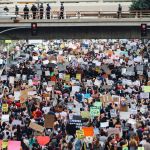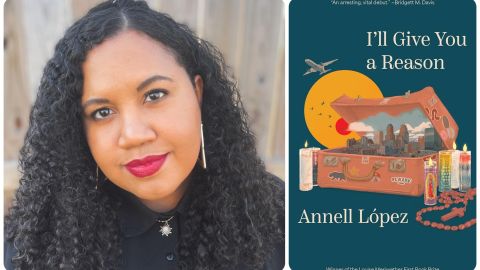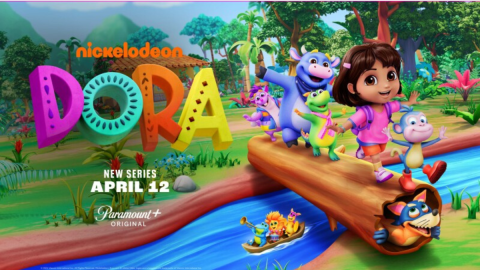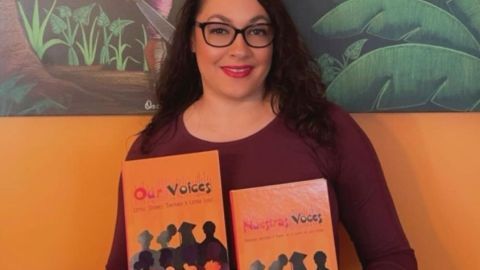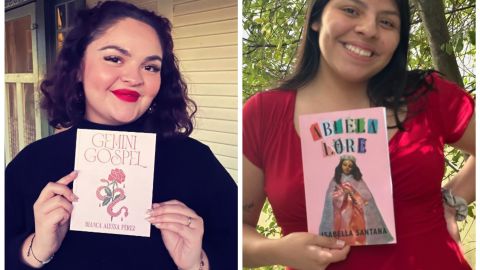Xicana Asian Muralist Marina Perez-Wong Is Using Art To Help Communities
Xicana Asian artist Marina-Perez Wong has used art to leave beautiful and powerful messages, in the form of murals splashed on walls, from San Francisco to Brooklyn

Photo: @twinwallsmuralcompany/Instagram/Courtesy of Marina-Perez Wong
Xicana Asian artist Marina-Perez Wong has used art to leave beautiful and powerful messages, in the form of murals splashed on walls, from San Francisco to Brooklyn. We recently spoke with the San Francisco native, on her work, her inspirations, and how being a Latina influences it all.
HipLatina: How did you get into art? What does art mean to you?
Wong: I started drawing and painting while I was in the hospital being treated for cancer as a baby. I had a Wilms tumor (one out of every million babies get it). My mom says that I was trying to use art as a form of communication, and a coping mechanism/ meditation for my situation. Things haven’t changed. That is still a huge part of what it means to me, but now it’s also for the communities I work in and ultimately, for the world. I realize that art is subjective but in my favorite form, it makes people create connections, be it emotional, intellectual or spiritual, etc.
Elaine Chu (my mural and business partner) and I began painting together in high school, circa 1996. She went to art college in Maryland, and I stayed in the Bay Area and went to the California College of Arts & Crafts in Oakland/San Francisco, but we always stayed in contact over the years. Eventually when Elaine moved back to SF, we both ended up working for Precita Eyes Muralists, and realized how well we worked together, and how much fun we had. Our friends hired us to paint their logo on the front facade of their building, and suggested that we start our own company. Our response being “Why didn’t we think of that!?” And thus began the twinsies, Twin Walls Mural Company. That was back in 2014.
HipLatina: How would you describe your artistic aesthetic? Are there certain themes/methods/symbols/colors/etc. that you come back to a lot?
Wong: “I normally paint semi realistically representational work, but I like switching it up too. For me personally, it’s not good to be stagnant. Thankfully, our murals reflect the communities or clients we work for, so it keeps things exciting. I don’t want to stop growing, so whenever I can, I like to challenge myself to learn new mediums and techniques. I especially love printmaking and ceramics. As far as color palette, I love all colors but I definitely lean more towards the use of saturated colors and contrast. That’s probably a metaphor for my life too. When I came out of the hospital, I lived in the Mission District in San Francisco, which was saturated with murals, culture, and depth of humanity.
Lately, we have been using a lot of green, in the hopes of manifesting health and growth. Elaine and I like to think that artists at best are healers and channelers of energy and were recently discussing the need for positive change in our present state of the people/city/nation/world. The world often feels like a big grey box full of grey people, who like being in a box, or putting other people in boxes. Our goal is to paint ourselves out of those prisons.
A lot of my/our work also tends to reflect women’s empowerment. That is intentional in our attempt to channel change in society. I was raised by goddessly-strong women. Being a shrimpy Latin Asian-mutt, and Elaine being a shrimpy Chinese woman out there on the street up on big scaffolding, is reflection enough of our attempt to stick it to the men who think we can’t do what we do because we’re fragile and feeble little girls.”
HipLatina: Which artists have you been influenced by?
Wong: My influences are many, and change with everything I learn and everyone new that I meet. But if I am starting from the beginning, I would have to start with my single parent strong Xicana mom in the way of life, but also in visual art. She was a photojournalist when I was growing up, so I think her work and the work of Mary Ellen Mark (one of her favorites) were influential in the way of content, composition and subject matter.
The biggest inspirations outside of my mom were the muralists I grew up seeing in my neighborhood. The Mission murals were packed with vibrancy, content (Latino history and local politics) and rooted in Mexican Muralism. And then of course there was Frida. Frida Kahlo having gone through her own set of physical trauma and operations, and being a soulful Mexican woman artist was always a kindred spirit. Dr. Maya Angelou, Dr. Martin Luther King Jr., Marsha Lee Pannone, and Stevie Wonder are also in this same light for me. The common thread being that they are/ were survivors, and always working toward the healing of people through art, education, peaceful protest, and love.

Photo: Twin Walls Mural Company/Courtesy of Marina-Perez Wong
HipLatina: How does being Latina influence your work?
Wong: Having been raised mostly Xicana, I think it is inherent in my work as an artist and in life that being Latina is a huge part of who I am as a person. I carry my ancestors with me all the time. They are in my heart, mind, and hands when I am in it.
As an artist, and a woman, it is a great challenge and a blessing to be able to do what we do. I feel like even in this day and age we are still not taken as seriously as we should be. We are the help. Sometimes the exoticized help or the girl. Even when we surpass the men in intelligence, skill, and talent, we are not getting full credit. That said, being feisty, intelligent women with a strong sense of history and culture (at least in my family), we burn a little brighter when forced to fight against these obstacles. Jajaja! It is important for me to reflect my culture when I’m painting, because I want to pass this form of empowerment down to other young brown girls. I have faith that they will be stronger and braver, and will pave new unknown paths with the sensibilities, self awareness, confidence, and freedoms that we are passing on, which were passed down to us.
HipLatina: Tell us about the Twin Murals Company. What major murals have you worked on?
Elaine Chu and I are twinsies. Not in blood, but in designing and painting. Hence the name Twin Walls Mural Company. Our dynamic is this, we share a similar aesthetic, and mural heart, but we don’t like painting the same things. Jajaja! When Twin one doesn’t want to paint part of the mural, Twin two wants to paint that part badly! And vice versa. Sometimes, though, we both have the potential to paint something well, we know the other will paint it better. Elaine often paints faster, and I paint slower. She gets paint all over her, and I am super clean. Jaja! There is no ego with the twinsies. I know her strengths, and she knows mine. I’d say we know each others weaknesses, but it’s less about weakness and more annoyance. Our suggestions are less critical, and more insightful. We both improve the piece. We take an equal amount of credit. We are a team, por siempre!
We just finished Twitter Headquarters’ (SF) first mural which we titled “She Inspires Me, Bringing her to Light.” We painted 104 inspirational portraits of women, most of which are hidden figures from the US, but also includes women from around the world. In the center, we painted three generations of women (a grandma, a baby, and mother) to explain that the women who are part of the ocean waves behind them are our past, present, and future. Our bodies are made up of mostly water. Water is life. Women are life. United, we are one of the most powerful forces in nature.
https://www.instagram.com/p/BkBxX9tB8sB/?tagged=clarionalley
We also just finished a small mural in Clarion Alley, which is a big deal for many artists, because you have to be invited to paint there or have submitted a piece and been selected. Some people have to wait years to get a wall. But the greatest honor about this particular mural was that we were asked to paint it in memory of Luis D.Góngora Pat. He was a man from the Yucatan, MX. who was unjustly murdered by the SF police two years ago.
Witnesses revealed that the police lied to cover their tracks, and the case has been swept under the rug these past two years, though local attorneys have been fighting it. His story is incredibly tragic, and his family was really thankful that we painted it. What struck me most was that his cousins told me “We’ve been here 23 years. We work really hard and we’re good people. I don’t understand why they treat us like this.” Elaine and I wanted to bring some justice to his life, by telling his story, which is heavily rooted in Mayan culture and family. It was probably the most meaningful mural I’ve worked on. Small but powerful.”
HipLatina: What other murals have you worked on, and where can they be seen?
Wong: “Koi, La Mission” in the Mission and “Hope. Act. The Fight for Freedom” in the Tenderloin this past summer are some of our larger works, but our most popular mural so far has been “La Flor De La Vida,” which was inspired by Frida Kahlo, and which we dedicated to Marsha Lee Pannone, who was our High School art teacher in our senior year at the SF School of the Arts. Mrs. Pannone is one of our greatest inspirations in life, like Frida. There are a lot of other smaller murals spread out but these have been some of our biggest accomplishments.
Elaine and I started painting murals way before we joined forces though. I started volunteering for Precita Eyes in 2005, and was hired by them shortly after. My favorite is a youth mural collaboration between HOMEY, Eric Norberg, Nancy Pili and 200+ local volunteers which is located on 24th and Capp st. in the Mission titled “Building Bridges of Solidarity, Breaking Down Barriers.” I painted a lot of the more rendered realistic looking portraits. When it was finished we had a huge block party, and the whole neighborhood came out. No drama, all family, oldies, lowriders, and comida! Everyone so proud. It was magic.
HipLatina: How is creating murals different in New York vs. San Francisco?
Wong: “I’ve worked with two mural organizations in New York and both were incredibly different than the one I worked for in SF but had similar outcomes, which is ultimately to connect with the community that they are painted in and to empower youth. The two in New York tended to weigh in a little heavier on the artists role, whereas Precita Eyes Muralists tends to lean more towards the communities vision. I myself always fall somewhere in the middle.
Street art in NYC and in SF is as different in personality as the people who live there. New York is fast and on hustle mode 24/7, with lots of history, which means there is a lot of work done fast and with style, but not all of it is done as well as it could be. In SF, the work is done slower and more deliberately in a relaxed fashion that has its own style, but we don’t get as many done as we could if we picked up the pace. Elaine and I are clearly working on breaking that standard this year though. Jajaja
HipLatina: What pieces of art are you the most proud of?
Wong: I’d say that my Carnaval Series and our Frida mural are the first to come to mind because of the amount of beautiful work I/we did within such a short amount of time. But I’d have to say my proudest moment came from a small mural that I painted which was dedicated to the people of Japan, and the Japanese community in SF just after the tsunami hit. I noticed this girl crouched down at the end of it while I was packing up for the day. At first I was angry and irritated because I thought she was tagging it and then I realized she was touching it and crying. She crouched there for a moment before she left a sand dollar on the stump below and walked away. It broke me a little, but it made me proud that I had made her feel and connect on that level. That’s what we’re here for.
HipLatina: What do you want people to know about San Francisco artists? Latino artists? Latina artists?
Wong: For the SF artists who are still here, in spite of being pushed out by the yuppies, hipsters, and now techies, we are holding our ground and preserving as much of what put this city on the map as possible. As far as my generation and the younger generation of Latinx artists go, I am always excited to see the work that is being produced in galleries, museums, and public spaces. Thanks to the influence of the previous generation of Latinx artists and the ones before, we can freely question our roles in society (race, culture, gender, and sexuality) and find strength and beauty in our own voices, in spite of these forced roles. It is a great time to be brown and proud.
HipLatina: What’s next for Marina Perez-Wong as an artist?
Wong: I am currently teaching Visual Art at the Oakland School for the Arts. I never expected to be teaching more than project based murals and occasionally art mentoring, but I absolutely love it. Our students are amazing, and our school is heavily focused on artistic craftsmanship, self expression and social justice. In the greatest sense, I have found my people, and it feels rewarding to be helping a younger generation see their own potential and accomplish their goals.
As far as Twin Walls Mural Company, you should expect Elaine and I to continue to paint the town and bring our flavor to the rest of the world. We are working on having some gallery shows as well as murals. More painting! More communities! More love! We are basically not going to be getting any sleep for the next few years. Jajaja!
You can follow Marina at
Instagram: @themissionblue and @twinwallsmuralcompany
Tumblr: Twin Walls Mural Company
Twitter: @TwinWallsMurals






